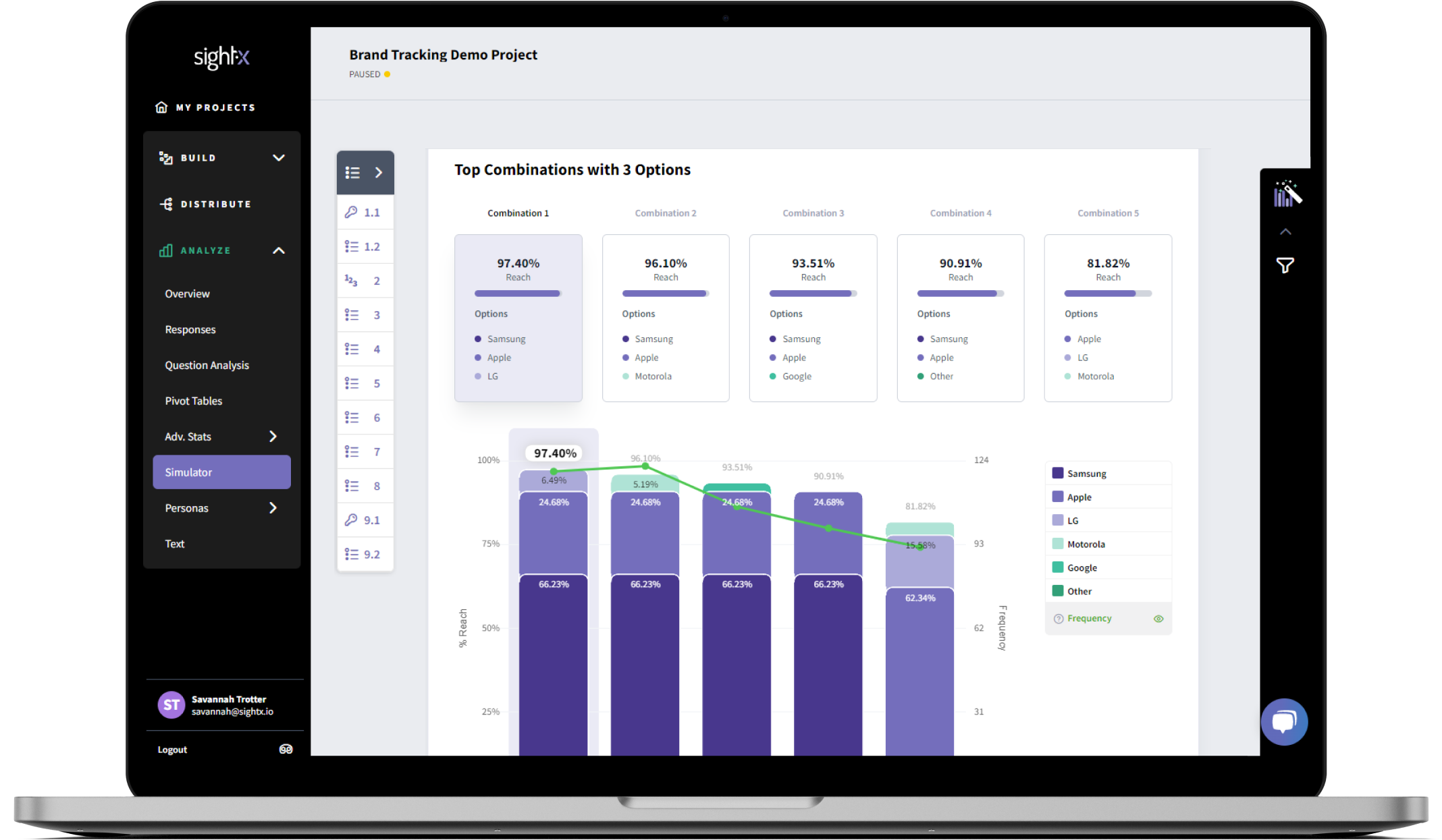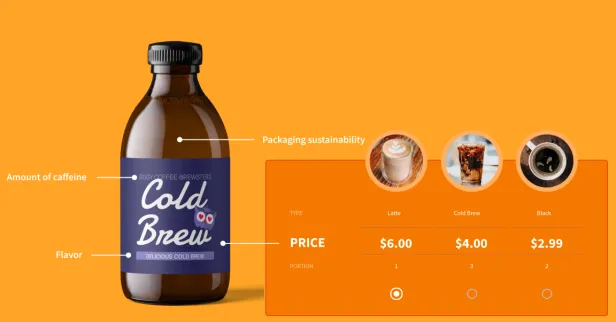TURF analysis gives you data-backed strategies to optimize your product offerings, marketing approach, and resource allocation to maximize your reach in competitive markets.
Today, we'll dive into TURF analysis use cases, practical examples, and ways to leverage SightX for effective TURF Analysis:
What is TURF Analysis?
TURF, which stands for Total Unduplicated Reach and Frequency, is a robust analytical method that provides valuable insights into how well a combination of products, services, or messages can cover the target market.
TURF Analysis is a quantitative research technique used primarily in marketing and product development to determine the optimal combination of offerings to maximize market reach and frequency of exposure.
TURF stands for "Total Unduplicated Reach and Frequency," which encapsulates its core objective: to identify the most effective mix of products or messages to reach the most significant unique audience without unnecessary overlap.
Key Components of TURF Analysis:
![]() Total Reach: The total number of unique individuals exposed to a combination of offerings. This metric provides an understanding of the overall market coverage.
Total Reach: The total number of unique individuals exposed to a combination of offerings. This metric provides an understanding of the overall market coverage.![]() Unduplicated Reach: The number of individuals exposed to at least one offering to ensure no overlap. This helps identify how many unique customers are being reached without repetition.
Unduplicated Reach: The number of individuals exposed to at least one offering to ensure no overlap. This helps identify how many unique customers are being reached without repetition.![]() Frequency: The number of times individuals are exposed to the offerings. Frequency measures the average number of exposures per person. It helps in understanding the repetition and reinforcement of messages or products.
Frequency: The number of times individuals are exposed to the offerings. Frequency measures the average number of exposures per person. It helps in understanding the repetition and reinforcement of messages or products.
By analyzing these components, TURF Analysis helps businesses understand how different combinations of products or messages can collectively cover the maximum number of unique customers, thus optimizing their reach and impact.
What is TURF Analysis Used for? 5 TURF Analysis Use Cases
Organizations use TURF Analysis for a wide range of applications in various business contexts. Its most popular uses are in product development marketing applications, like:
Product Line Optimization
Arguably, the most popular case for TURF analysis is determining the optimal combination of products to offer within a product line. Using advanced analysis, TURF maximizes reach by ensuring the products in a portfolio cover the broadest possible audience, minimizing redundancy and overlap.
For example, a sparkling water company would use TURF analysis to identify the right mix of flavors to offer to ensure the product line appeals to a diverse group of customers.
Product Development
TURF analysis isn't just for product lines; it can also help you identify gaps in your product and prioritize features that will net you new customers.
For example, a software company might use TURF Analysis to help prioritize items in an upcoming release. This will guarantee that the development resources focus on features that appeal to the broadest audience.
Marketing and Advertising
In marketing, TURF analysis evaluates different combinations of messages, channels, or advertisements to identify the mix that reaches the most people. This helps optimize ad spend and improve campaign effectiveness.
For example, a marketing department might use a TURF analysis to identify the social channels their audiences use most and allocate their marketing efforts toward those platforms.
Retail Assortment Planning
Retailers use TURF Analysis to optimize their product assortment and shelf space. By identifying the combination of products that maximize reach, retailers can ensure that their stores carry the most appealing mix of items, thus driving sales and customer satisfaction.
Media and Content Strategy
Media companies can leverage TURF Analysis to plan their content strategy effectively. By understanding which combination of shows, movies, or articles will attract the largest unique audience, they can curate a content mix that maximizes viewership and engagement.
TURF Analysis Examples
 Consumer Goods
Consumer Goods
A consumer goods company wants to optimize its snack product line to ensure it covers the maximum number of unique customers. Using TURF Analysis, the company can evaluate different combinations of snacks to identify the mix that provides the highest total and unduplicated reach, ensuring that their product line appeals to the broadest audience without unnecessary overlap. This approach helps the company reduce product redundancy and focus on offerings with the widest appeal.
 Media and Entertainment
Media and Entertainment
A media company is planning its content strategy and wants to understand which combination of TV shows, movies, and streaming content will attract the most extensive unique viewership. TURF Analysis helps the company determine the optimal content mix that maximizes reach and frequency of engagement, thereby increasing viewer retention and satisfaction. For instance, the company might find that a combination of comedy, drama, and reality TV shows reaches the broadest audience, enabling them to allocate resources effectively across these genres.
 Retail
Retail
A retail chain is looking to optimize its promotional strategies across various channels (e.g., in-store, online, email marketing, social media). By conducting a TURF Analysis, the retailer can identify the combination of promotional channels that maximize reach and frequency, ensuring that marketing efforts are not duplicated and resources are used efficiently. For example, the retailer might discover that a mix of email newsletters, social media ads, and in-store promotions covers the largest unique audience, leading to a more effective marketing strategy.
 Technology Products
Technology Products
A tech company is developing a new line of smart home devices and wants to ensure its product portfolio covers the widest possible audience. Using TURF Analysis, the company can determine the optimal mix of devices (e.g., smart speakers, cameras, thermostats) that maximize market reach while minimizing product overlap. This analysis helps the company focus on the most impactful products, ensuring broad market coverage and reducing the risk of redundant offerings.
 Financial Services
Financial Services
A financial services firm plans to launch a suite of new investment products and wants to ensure they appeal to a wide range of customers. By conducting a TURF Analysis, the firm can evaluate different combinations of investment products to determine the mix that maximizes reach. This allows the firm to create a well-rounded product portfolio that meets the diverse needs of its customers, enhancing market penetration and customer satisfaction.
 Healthcare and Pharmaceuticals
Healthcare and Pharmaceuticals
A pharmaceutical company is developing a new range of medications and treatments. TURF Analysis can help the company understand which combination of treatments will cover the widest range of patient needs. This ensures that the product development efforts are focused on the most impactful treatments, maximizing reach and improving patient outcomes.

TURF Analysis with SightX
At SightX, we infuse the power of generative AI into advanced market research tools so you can:
![]() Create fully customized tests and experiments with a prompt.
Create fully customized tests and experiments with a prompt.![]() Collect data from your target audience.
Collect data from your target audience.![]() Receive fully analyzed and summarized results in seconds, revealing key insights and personalized recommendations.
Receive fully analyzed and summarized results in seconds, revealing key insights and personalized recommendations.
Let us show you how simple it can be to collect powerful insights.
